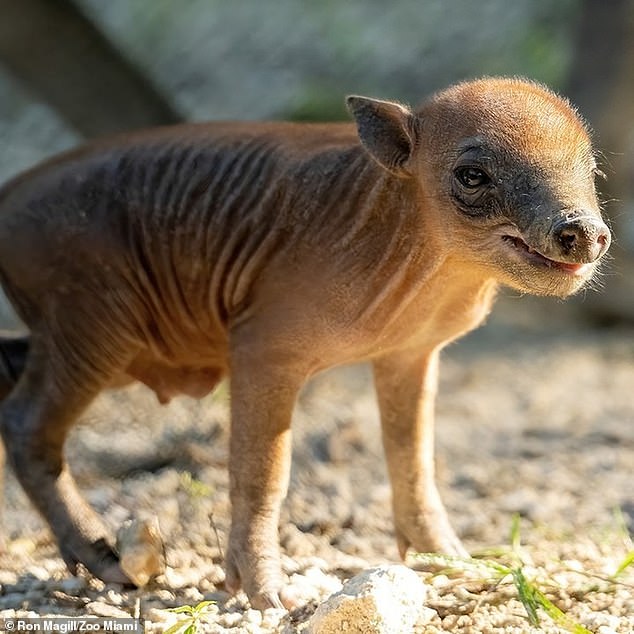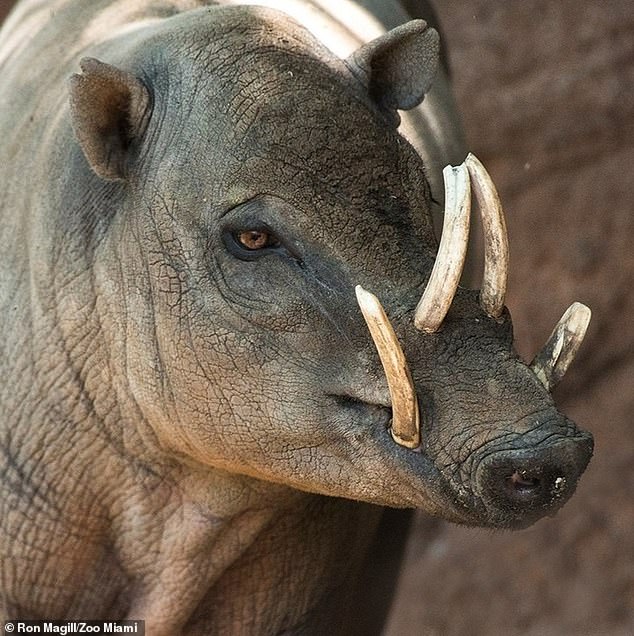'Bizarre-looking' endangered 'Pig Deer' is born to parents Maggie and Harry at Miami Zoo – a year after mother had a stillborn child
- For the first time in zoo history, a babirusa was born at Zoo Miami
- The zoo has not officially identified the sex of the babirusa, but believes it is male
- READ MORE: First photos taken of Babirusa's birth
<!–
<!–
<!– <!–
<!–
<!–
<!–
The Zoom Miami welcomed the birth of a 'bizarre-looking' endangered 'Pig Deer' to parents Maggie and Harry.
The baby babirusa was born on December 15 – the zoo just announced the event – and is said to be healthy as he waits in isolation with his mother before making his debut.
Keeping the mother and baby isolated is essential to ensure safety in the enclosure, Ron Magill, communications director for Zoo Miami, told Dailymail.com.
Zoo officials said they are excited about the new bundle of joy as Maggie previously delivered a stillborn child a year ago.
The babirusa species is native to Indonesia and there are fewer than 10,000 left in the world.

A baby babirusa, believed to be male, was born at Zoo Miami last month, marking the first successful birth in the zoo's history


The baby babirusa is currently in isolation with his mother Maggie while he gets used to being at the zoo
“The possibility of the baby falling into the moat if introduced too early causes zookeepers to be extra cautious,” Magill said.
He continued: 'Our challenge now is to ensure that the baby is confident enough to navigate the exhibit habitat safely.
'…We suspect it will be a few more weeks before mother and baby are given free access to the exhibit habitat.'
Maggie and her baby will likely remain in isolation for a few weeks before they can be introduced to the habitat. Magill said.
He confirmed that mother and baby Babirusa are doing well and have already begun to show greater tolerance towards zookeepers and approach them for special treats.
The zoo has yet to officially determine the baby's gender, but Magill said they are “somewhat confident it is a male.”


Harry, the father of baby Babirusa, is still on display at the zoo for the public
The babirusa species is native to Indonesia and is threatened by excessive hunting and poaching for their meat and habitat loss due to agricultural development.
It is widely regarded as one of the most bizarre vantage points of more than twenty different pig species in the world due to the tusks that grow from the tops of the males' heads and which closely resemble antlers.
He also has upper tusks that grow through the top of his face and sometimes curl back into his head, and lower tusks that curl up and away from his head.
Although the tusks are not present in females, the male features “create an almost alien appearance that causes many to consider the babirusa the strangest-looking pig in the world,” Zoo Miami said in a press release.
At birth, babirusas weigh less than 1.7 kg, but at full growth adult males can weigh up to 220 kg and in the wild have a typical lifespan of seven to ten years, but under human care they can live up to 24 years.
The Babirusa is on the IUCN Red List, despite having few or no natural enemies population estimated at less than 10,000 worldwide.
